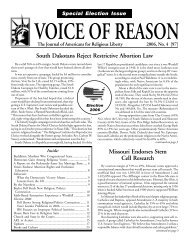The Importance of Church-State Separation - Americans for ...
The Importance of Church-State Separation - Americans for ...
The Importance of Church-State Separation - Americans for ...
Create successful ePaper yourself
Turn your PDF publications into a flip-book with our unique Google optimized e-Paper software.
10<br />
religious neutrality required by the First Amendment. . . .” 27 In August<br />
1995, the US Department <strong>of</strong> Education issued advisory guidelines to all<br />
school districts on religious expression in public schools. At the 1998<br />
Civil Rights Commission hearing, Julie Underwood, general counsel<br />
<strong>for</strong> the National School Boards Association, told the hearings that inquiries<br />
to the NSBA about what is or is not permitted in public schools<br />
declined almost to the vanishing point once the guidelines were published.<br />
28<br />
<strong>The</strong> guidelines grew out <strong>of</strong> a document titled “Religion in the Public<br />
Schools: A Joint <strong>State</strong>ment <strong>of</strong> Current Law,” issued in April 1995 by<br />
a broad coalition <strong>of</strong> thirty-six religious and civil liberties groups. Declaring<br />
that the Constitution “permits much private religious activity in<br />
and around the public schools and does not turn the schools into religion-free<br />
zones,” the statement went on to detail what is and is not<br />
permissible in the schools. 29<br />
On July 12, 1995, President Clinton discussed these issues in a<br />
major address at – appropriately – James Madison High School in<br />
northern Virginia and announced that he was directing the secretary <strong>of</strong><br />
education, in consultation with the attorney general, to issue advisory<br />
guidelines to every public school district in the country. <strong>The</strong> guidelines<br />
were issued in August. In his weekly radio address <strong>of</strong> May 30, 1998,<br />
anticipating the June 4 House debate and vote on the Istook (R-OK)<br />
school prayer amendment, President Clinton again addressed the issue<br />
and announced that the guidelines, updated slightly, were being reissued<br />
and sent to every school district. This ef<strong>for</strong>t undoubtedly helped<br />
to sway the House to vote down the Istook amendment.<br />
<strong>The</strong> guidelines, based on fifty years <strong>of</strong> court rulings (from the 1948<br />
McCollum decision to the present), on common sense, and on a healthy<br />
respect <strong>for</strong> American religious diversity, have proved useful to school<br />
boards, administrators, teachers, students, parents, and religious leaders.<br />
Following is a brief summary:<br />
Permitted: “Purely private religious speech by students”;<br />
nondisruptive individual or group prayer, grace be<strong>for</strong>e meals, religious<br />
literature reading; student speech about religion or anything<br />
else, including that intended to persuade, as long as it stops short <strong>of</strong><br />
harassment; private baccalaureate services; teaching about religion;<br />
inclusion by students <strong>of</strong> religious matter in written or oral<br />
assignments where not inappropriate; student distribution <strong>of</strong> religious<br />
literature on the same terms as other material not related to



